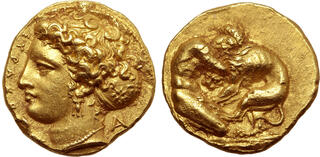| Roma Numismatics Ltd > Auction XXX | Auction date: 21 March 2024 |
| Lot number: 69 Price realized: 20,000 GBP (Approx. 25,336 USD / 23,327 EUR) Note: Prices do not include buyer's fees. | Show similar lots on CoinArchives Find similar lots in upcoming auctions on |
| Lot description: Sicily, Syracuse AV 100 Litrai - Double Dekadrachm. Dionysios I, circa 405-400 BC. Unsigned dies in the style of Kimon. Head of Arethusa to left, wearing triple-pendant earring and necklace, hair in sphendone ornamented with two stars; ΣYPAKO[ΣIΩN] before, A behind / Herakles kneeling to right, strangling the Nemean Lion. Bérend 30; Gulbenkian 324 (same dies); Rizzo pl. L, 12 (same rev. die); SNG ANS 332-333 (same dies); Pozzi 606 (A rather than AK behind); Jameson 1917 var. (A behind); HGC 2, 1275 var. (same). 5.78g, 15mm, 3h. Good Extremely Fine; small edge mark, otherwise a spectacular example with a crisp portrait in high relief. Extremely Rare; a very rare denomination in itself, and furthermore a variety unpublished in a number of the major collections. Ex Jean Vinchon Numismatique, June 2022 Auction, 29 June 2022, lot 24 (hammer: EUR 50,000). This particular issue dates to circa 405 BC, following the election of Dionysios as supreme military commander of Syracuse in recognition of his achievements in the war against Carthage and his subsequent seizure of total power. Syracuse had only recently repelled an Athenian invasion of Sicily that resulted in the complete destruction of Athens' expeditionary force and ultimately contributed significantly to Athens' defeat at the hands of Sparta in the Peloponnesian War. Then under Dionysios in 405 BC, despite the ruin of great cities such as Akragas and Gela, Syracuse overcame a Carthaginian invasion that might have resulted in a comprehensive conquest of the island. Such glory was short-lived, however, as the rule of Dionysios' son and successor was to bring civil strife that would weaken the power of Syracuse. Never again would the city issue coinage on such a grand scale, and this coin represents part of the last great flourishing of classical numismatic art at Syracuse before two centuries of steady decline and eventual conquest at the hands of the Romans. The wonderful Syracusan 100 litrai or double dekadrachms are considered amongst some of the finest gold coinage of the Greek world, and are associated with the magnificent dekadrachms of Euainetos, whose signature also appears on the earlier dies of the gold denomination issue. The serenely graceful head of the sea-nymph Arethusa, rendered in very similar style to the great die-engraver Euainetos, is presented in delightful contrast to the dynamic rendering of the first labour of Hercules, the slaying of the Nemean lion, on the reverse. The die-engraver's masterful composition within the bounds of a circular constraint produces a scene of great power and climax, both Herakles' and the lion's backs arched as the hero bends to tighten his grip around the lion's neck and it strains desperately against him to escape. As a great Doric hero and ancestor of the Doric city of Syracuse, Herakles' defeat of the lion, the symbol of Africa, has powerful connotations for Syracuse's own conflict with the African city of Carthage. Estimate: 30000 GBP |  |


